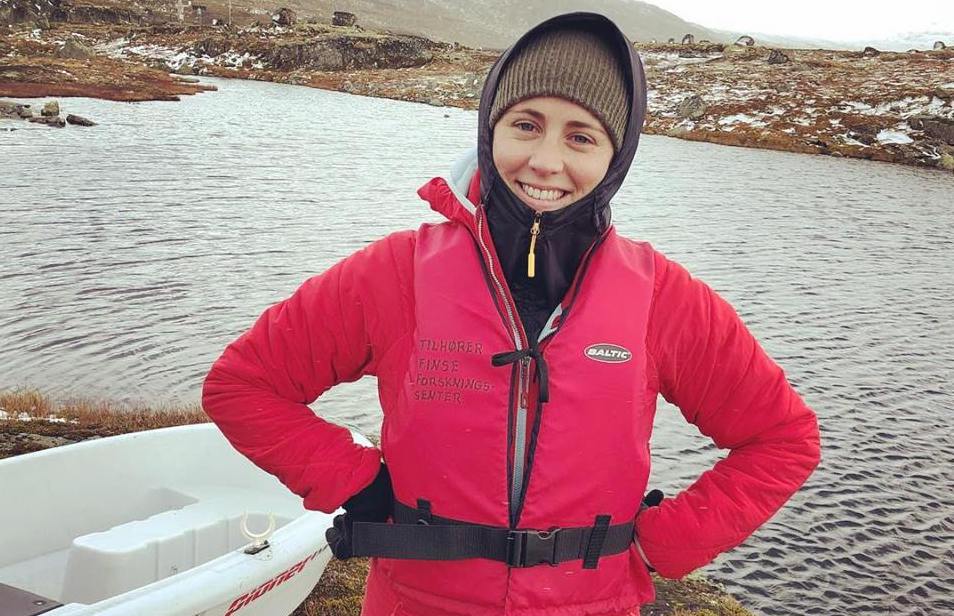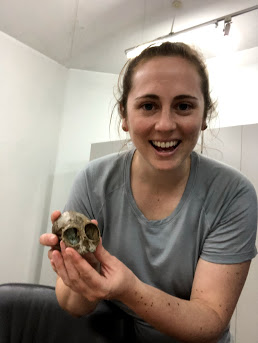Rachel Lupien On Talking It Out
Paleoclimatologist Dr. Rachel Lupien shares why making time for conversation and connection with other scientists helped her find her own path in science.
This article is from our limited-run newsletter series, Sincerely Science. Read more from the series, or sign up to receive all 6 editions of this series in your inbox.

Late into her graduate program, Dr. Rachel Lupien had a problem. She had never done any fieldwork.
Lupien is a paleoclimatologist, which means she studies climate change in the past. Revealing past climate behavior can help us understand human evolution and have implications for how ecosystems will respond to climate change in the future. She mainly uses sediment cores from lakes and the ocean to do her research, which calls for traveling across the world to retrieve these cores from the ground.
“I like to travel, but I don’t have a huge drive to go into the field. I remember I was very self-conscious about that,” Lupien says.
On her first fieldwork trip, Lupien helped collect sediment cores from a lake on the Indonesian island of Sulawesi. Because it was too windy to core during the day, her team ended up coring by moonlight at 2 a.m. “It [was] actually the most pleasant time of day to be outside,” Lupien says. “Later, I found out there were crocodiles in that lake.”
Lupien says talking to other scientists about their preferences has been helpful in forming her own path, even if it’s not the most traditional one.
“I heard a great scientist who was a big deal to me say that she doesn’t like doing fieldwork. And I [thought], ‘Oh my God, we can still be Earth scientists and feel this way.’”
Although fieldwork is a big part of geology research, Lupien prefers to use data from sediment cores that are already collected.

“There’s so much more left to be done on these archives,” Lupien says. “People forget about them. You can be an Earth scientist and paleoclimatologist and have these really cool field areas, but not actually have to go into the field to do your work.”
In fact, sampling from archives led Lupien to the coolest thing she says she’s ever done on the job. While she was visiting the Turkana Basin Institute in Kenya, she was able to see the fossil vaults. “I got to hold Turkana Boy’s skull. There’s a picture of me holding a 14 million-year-old baby ape skull. It gives me shivers just thinking of it.”
Lupien says she was fortunate to have had very supportive advisors in both her postdoc and PhD, but setting up a network of peer mentors was how she learned where she fits in the world of professional science.
“If you’re open with your friends about things, and not just your immediate peers, but peers a couple [of] years ahead of you, then they’ll open up with you too. I’ve had a really nice mentoring network of people who were just three years ahead of me [who were] publishing and looking for jobs,” Lupien says.
Networking and publishing can be somewhat opaque processes for early career scientists, and Lupien was determined to make them as accessible as possible for herself and others. When she was a postdoc at Lamont, Lupien started a mentoring network specifically for PhDs in postdocs, “so that we could demystify this transition,” she says.
Today, as an assistant professor in Aarhus, Denmark, Lupien co-hosts a podcast called How We Got Here: Because The Earth Needs Professional Help. Its mission is to inspire people from any field to join in the fight against climate change, and to bridge some of the informational gaps to getting there. Before they introduce any guest, Lupien and her co-host Dr. Stephanie Spera, an assistant professor of Geography and Environment at the University of Richmond, talk about something that went well and something that went off-course for both of them that week, to set an open and honest tone.
“The real goal of it is to demystify all of these different potential career paths for people who really want to fight climate change,” Lupien says. “We’re all different.”
It can be especially vulnerable to share difficult or personal career stories with peers as an advanced scientist. But Lupien hopes to break that silence in an effort to show how common it is for projects to take an unexpected path at any stage in a person’s career.
Lupien submitted a study that she was proud of to a journal, which resulted in critical feedback and a rejection. After the initial rejection and round of revisions, it got rejected four more times. It was published in the sixth journal Lupien’s team submitted it to, which is “unheard of,” she says.
“I had to report back to all 20 co-authors to [say], ‘Guys, thank you for being patient with this project, but it’s still getting rejected.’” After further revision, the paper got published in Scientific Reports in February of 2022.
Afterward, she tweeted about her experience.
This paper was… a lot [*rejected at 5 journals*]. I am v grateful for the most supportive coauthors #jim @GeochemEm @UMassBiogeochem @asfish2010 @FoersterVerena @henryflamb @HelenRobertsOSL @FSchaeb @MartinHTrauth @Cat_Beck Craig Feibel + Andy Cohen
50th paper of @HSPDPinfo!
— Rachel Lupien (@loopdlupien) February 24, 2022
“I think it’s really important to talk about. Because if nobody talks about it, then you think that it doesn’t happen to anyone else, which is not true,” Lupien says.
“I’m a fan of transparency. And I’m really happy with that paper.”
Emma Lee Gometz is Science Friday’s Digital Producer of Engagement. She writes SciFri’s “Science Goes To The Movies” series and is a journalist and illustrator based in Queens, NY.